Critical Review of the Granville Train Disaster: Case Study Analysis
VerifiedAdded on 2020/03/01
|10
|2209
|61
Case Study
AI Summary
This case study critically reviews the Granville train disaster, a significant railway accident in Australia. The review begins with an overview of the incident background, detailing the derailment and bridge collapse that resulted in numerous fatalities and injuries. It then delves into the reasons behind the accident, highlighting factors such as track maintenance issues, infrastructure deficiencies, and human errors. The case study further examines the lessons learned from the disaster, emphasizing the importance of safety management, employee training, and effective emergency response. Finally, it outlines the policy changes and implementations that followed the incident, including reforms to safety guidelines, infrastructure improvements, and the establishment of regulatory bodies to prevent similar tragedies in the future. The analysis underscores the critical need for robust safety measures and proactive risk management in public transport systems.
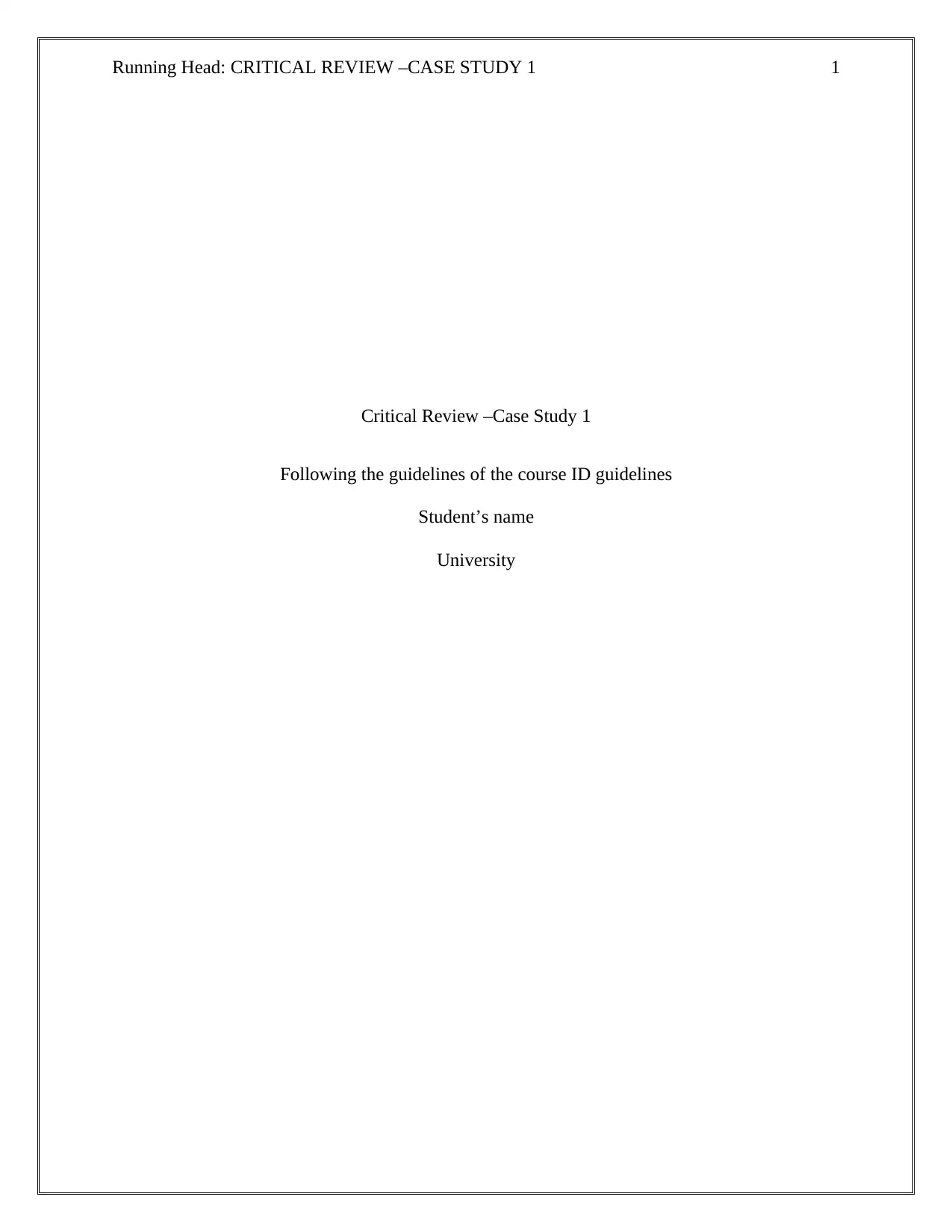
Running Head: CRITICAL REVIEW –CASE STUDY 1 1
Critical Review –Case Study 1
Following the guidelines of the course ID guidelines
Student’s name
University
Critical Review –Case Study 1
Following the guidelines of the course ID guidelines
Student’s name
University
Paraphrase This Document
Need a fresh take? Get an instant paraphrase of this document with our AI Paraphraser
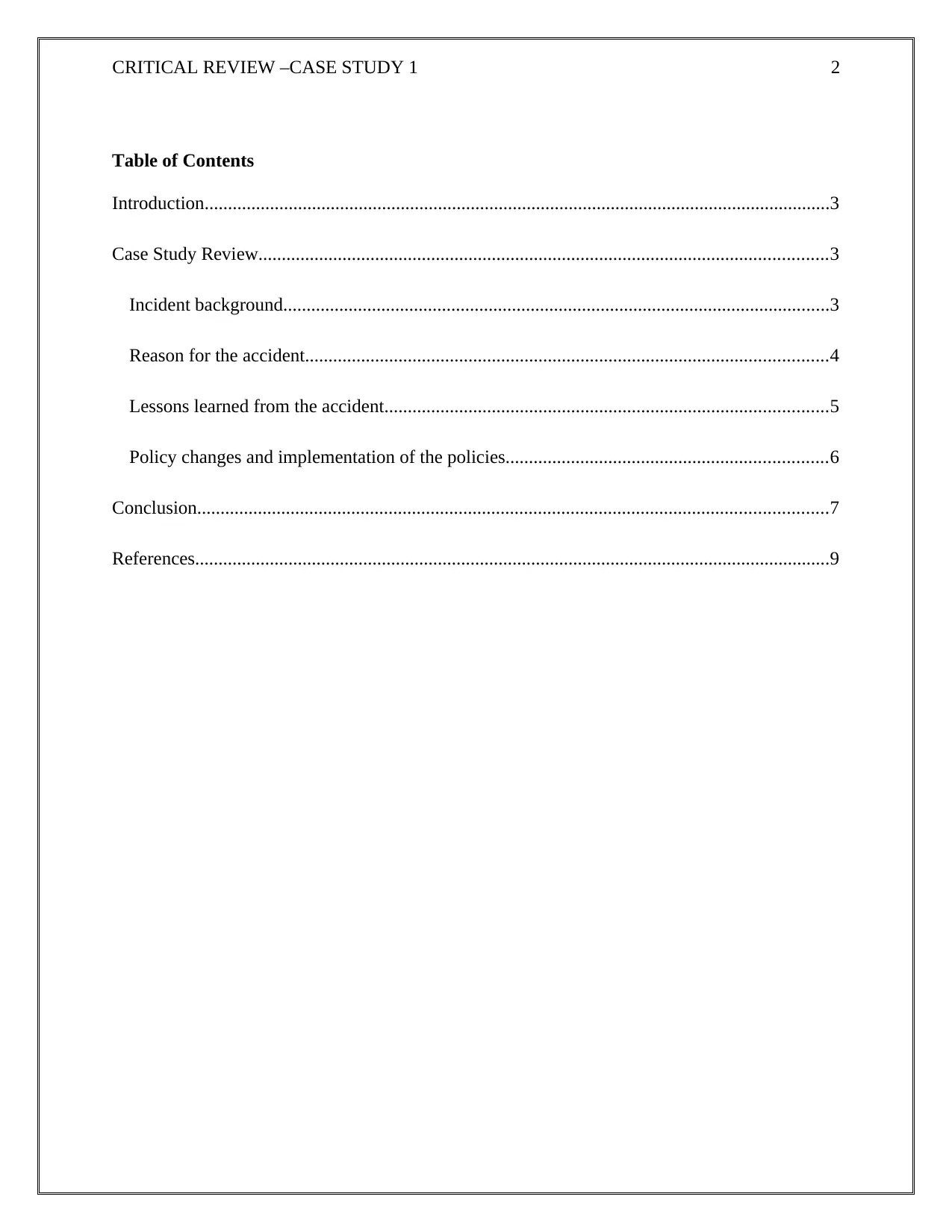
CRITICAL REVIEW –CASE STUDY 1 2
Table of Contents
Introduction......................................................................................................................................3
Case Study Review..........................................................................................................................3
Incident background.....................................................................................................................3
Reason for the accident................................................................................................................4
Lessons learned from the accident...............................................................................................5
Policy changes and implementation of the policies.....................................................................6
Conclusion.......................................................................................................................................7
References........................................................................................................................................9
Table of Contents
Introduction......................................................................................................................................3
Case Study Review..........................................................................................................................3
Incident background.....................................................................................................................3
Reason for the accident................................................................................................................4
Lessons learned from the accident...............................................................................................5
Policy changes and implementation of the policies.....................................................................6
Conclusion.......................................................................................................................................7
References........................................................................................................................................9

CRITICAL REVIEW –CASE STUDY 1 3
Introduction
Safety management is a process in which the risk of damage and harm to a person is
identified and necessary policies are developed to maintain a proper environment at workplace
(Glendon & Clarke, 2016). Moreover, safety management is the processes, procedures, structure,
resources and people of an organisation required to attain the objective of the safety management
policies. In the safety and risk management process, the hazards are identified using risk
identification and risk assessment techniques in order to keep the employees and other
stakeholders safe from the operations of the organisation (Bramson, 2009). However, it is
important to note that lack of attention, casual attitude of the employees and breaches of safety
policies may lead to different types of hazards at workplace. Hence, it is important for the
management to identify, implement, ensure and monitor the safety policies effectively in order to
maintain a safe and healthy environment at workplace. On the basis of the above facts, the case
study of Granville train crash can is Australia has been identified in order to evaluate the factors
leading to safety breaches and occurrence of one of the largest disaster in the history of
Australian Railway. Furthermore, the paper presents the changes in the railway safety policy
implemented by the Australian Railway Ministry in order to avoid the occurrence of railway
disaster in the future.
Case Study Review
Incident background
Granville train crash can be identified as the most unfortunate rail disaster in Australia.
On January 18, 1977, a Sydney-bound train derailed in Granville suburb, New South Wales
Introduction
Safety management is a process in which the risk of damage and harm to a person is
identified and necessary policies are developed to maintain a proper environment at workplace
(Glendon & Clarke, 2016). Moreover, safety management is the processes, procedures, structure,
resources and people of an organisation required to attain the objective of the safety management
policies. In the safety and risk management process, the hazards are identified using risk
identification and risk assessment techniques in order to keep the employees and other
stakeholders safe from the operations of the organisation (Bramson, 2009). However, it is
important to note that lack of attention, casual attitude of the employees and breaches of safety
policies may lead to different types of hazards at workplace. Hence, it is important for the
management to identify, implement, ensure and monitor the safety policies effectively in order to
maintain a safe and healthy environment at workplace. On the basis of the above facts, the case
study of Granville train crash can is Australia has been identified in order to evaluate the factors
leading to safety breaches and occurrence of one of the largest disaster in the history of
Australian Railway. Furthermore, the paper presents the changes in the railway safety policy
implemented by the Australian Railway Ministry in order to avoid the occurrence of railway
disaster in the future.
Case Study Review
Incident background
Granville train crash can be identified as the most unfortunate rail disaster in Australia.
On January 18, 1977, a Sydney-bound train derailed in Granville suburb, New South Wales
⊘ This is a preview!⊘
Do you want full access?
Subscribe today to unlock all pages.

Trusted by 1+ million students worldwide

CRITICAL REVIEW –CASE STUDY 1 4
(Duncan, 2017). The Granville train disaster took place when a commuter train derailed and hit
the supporting pillars of a road bridge resulting in collapsing the bridge over the train near
Granville station. Due to the collision, 470 tonnes of the concrete section of the bridge collapsed
over the carriages three and four of the train. According to the reports, 84 people were killed and
213 were injured in the most tragic train accident in Australia (Bell, 2017).
Evidently, two of the carriages of the locomotive hit severely as the entire mass of the
steel and concrete bridge rained over them. In order to rescue the injured passengers, the rescue
team faced significant challenges as leaking gas had forced not to use oxy-acetylene cutting
tools. The efforts of the emergency rescue crew were highly appreciated following the rescue
operations. In the meanwhile, the most tragic train crash in the Australian history has provided
crucial lessons to be followed so that such nasty mishaps can be avoided (Hudoklin & Rozman,
2012).
Reason for the accident
The aftermath of the tragic accident was important because it was essential to investigate
the reason behind the train crash. In February 1977, an inquiry commission was set up under the
supervision of the then NSW District Court Chief Judge. According to the reports of the inquiry
team, it was revealed a number of reasons were involved that were collectively contributed to the
unfortunate train accident (Duncan, 2017). Shockingly, the report clarified that the Bold Street
Bridge was previously hit by derailments at the same section before. In spite of such derailments,
lack of proper actions led to the tragic mishap. Also, the report stated that the condition of the
railway track was so unsatisfactory. Moreover, the track was badly aligned and it had stretched
wider than standard gauge causing the derailment of the train.
(Duncan, 2017). The Granville train disaster took place when a commuter train derailed and hit
the supporting pillars of a road bridge resulting in collapsing the bridge over the train near
Granville station. Due to the collision, 470 tonnes of the concrete section of the bridge collapsed
over the carriages three and four of the train. According to the reports, 84 people were killed and
213 were injured in the most tragic train accident in Australia (Bell, 2017).
Evidently, two of the carriages of the locomotive hit severely as the entire mass of the
steel and concrete bridge rained over them. In order to rescue the injured passengers, the rescue
team faced significant challenges as leaking gas had forced not to use oxy-acetylene cutting
tools. The efforts of the emergency rescue crew were highly appreciated following the rescue
operations. In the meanwhile, the most tragic train crash in the Australian history has provided
crucial lessons to be followed so that such nasty mishaps can be avoided (Hudoklin & Rozman,
2012).
Reason for the accident
The aftermath of the tragic accident was important because it was essential to investigate
the reason behind the train crash. In February 1977, an inquiry commission was set up under the
supervision of the then NSW District Court Chief Judge. According to the reports of the inquiry
team, it was revealed a number of reasons were involved that were collectively contributed to the
unfortunate train accident (Duncan, 2017). Shockingly, the report clarified that the Bold Street
Bridge was previously hit by derailments at the same section before. In spite of such derailments,
lack of proper actions led to the tragic mishap. Also, the report stated that the condition of the
railway track was so unsatisfactory. Moreover, the track was badly aligned and it had stretched
wider than standard gauge causing the derailment of the train.
Paraphrase This Document
Need a fresh take? Get an instant paraphrase of this document with our AI Paraphraser
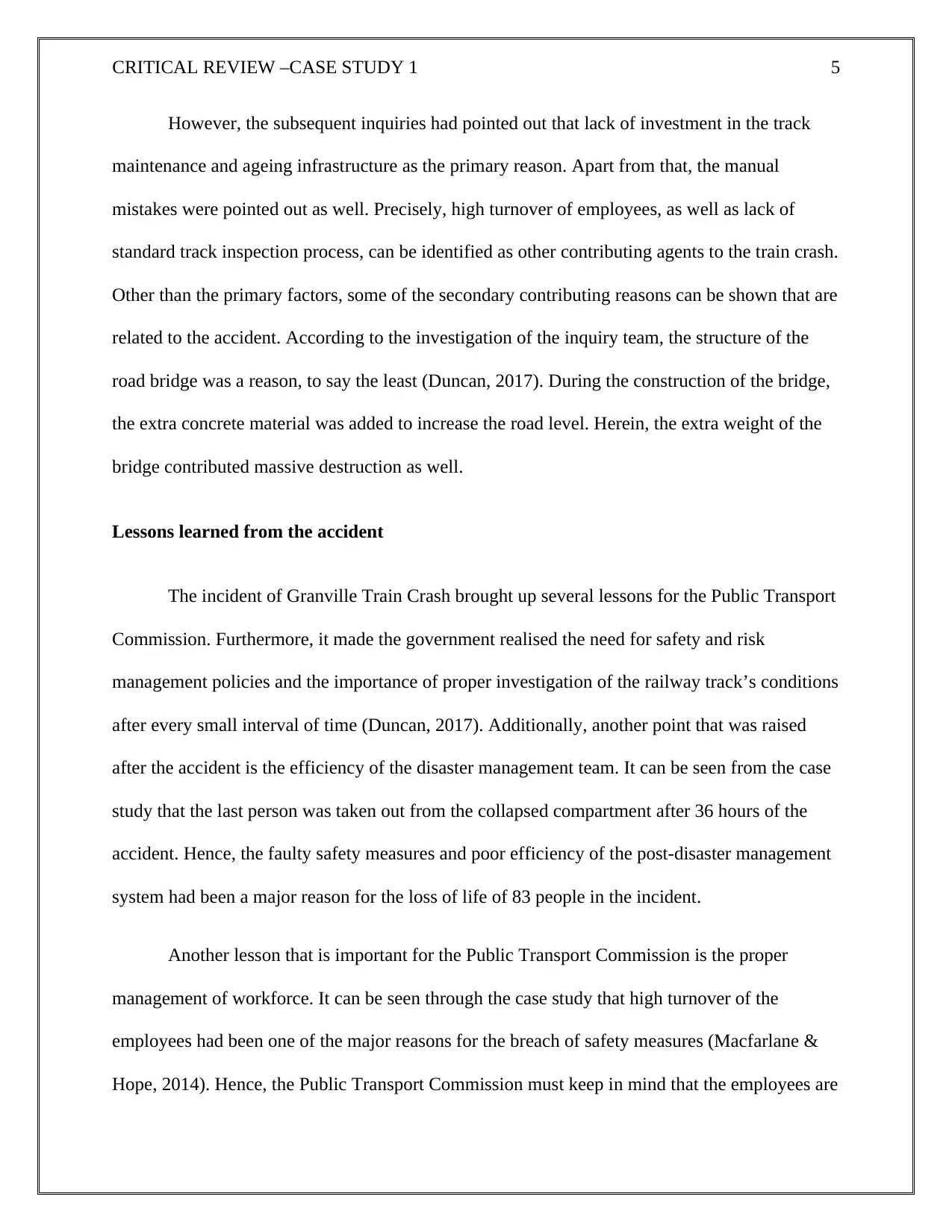
CRITICAL REVIEW –CASE STUDY 1 5
However, the subsequent inquiries had pointed out that lack of investment in the track
maintenance and ageing infrastructure as the primary reason. Apart from that, the manual
mistakes were pointed out as well. Precisely, high turnover of employees, as well as lack of
standard track inspection process, can be identified as other contributing agents to the train crash.
Other than the primary factors, some of the secondary contributing reasons can be shown that are
related to the accident. According to the investigation of the inquiry team, the structure of the
road bridge was a reason, to say the least (Duncan, 2017). During the construction of the bridge,
the extra concrete material was added to increase the road level. Herein, the extra weight of the
bridge contributed massive destruction as well.
Lessons learned from the accident
The incident of Granville Train Crash brought up several lessons for the Public Transport
Commission. Furthermore, it made the government realised the need for safety and risk
management policies and the importance of proper investigation of the railway track’s conditions
after every small interval of time (Duncan, 2017). Additionally, another point that was raised
after the accident is the efficiency of the disaster management team. It can be seen from the case
study that the last person was taken out from the collapsed compartment after 36 hours of the
accident. Hence, the faulty safety measures and poor efficiency of the post-disaster management
system had been a major reason for the loss of life of 83 people in the incident.
Another lesson that is important for the Public Transport Commission is the proper
management of workforce. It can be seen through the case study that high turnover of the
employees had been one of the major reasons for the breach of safety measures (Macfarlane &
Hope, 2014). Hence, the Public Transport Commission must keep in mind that the employees are
However, the subsequent inquiries had pointed out that lack of investment in the track
maintenance and ageing infrastructure as the primary reason. Apart from that, the manual
mistakes were pointed out as well. Precisely, high turnover of employees, as well as lack of
standard track inspection process, can be identified as other contributing agents to the train crash.
Other than the primary factors, some of the secondary contributing reasons can be shown that are
related to the accident. According to the investigation of the inquiry team, the structure of the
road bridge was a reason, to say the least (Duncan, 2017). During the construction of the bridge,
the extra concrete material was added to increase the road level. Herein, the extra weight of the
bridge contributed massive destruction as well.
Lessons learned from the accident
The incident of Granville Train Crash brought up several lessons for the Public Transport
Commission. Furthermore, it made the government realised the need for safety and risk
management policies and the importance of proper investigation of the railway track’s conditions
after every small interval of time (Duncan, 2017). Additionally, another point that was raised
after the accident is the efficiency of the disaster management team. It can be seen from the case
study that the last person was taken out from the collapsed compartment after 36 hours of the
accident. Hence, the faulty safety measures and poor efficiency of the post-disaster management
system had been a major reason for the loss of life of 83 people in the incident.
Another lesson that is important for the Public Transport Commission is the proper
management of workforce. It can be seen through the case study that high turnover of the
employees had been one of the major reasons for the breach of safety measures (Macfarlane &
Hope, 2014). Hence, the Public Transport Commission must keep in mind that the employees are
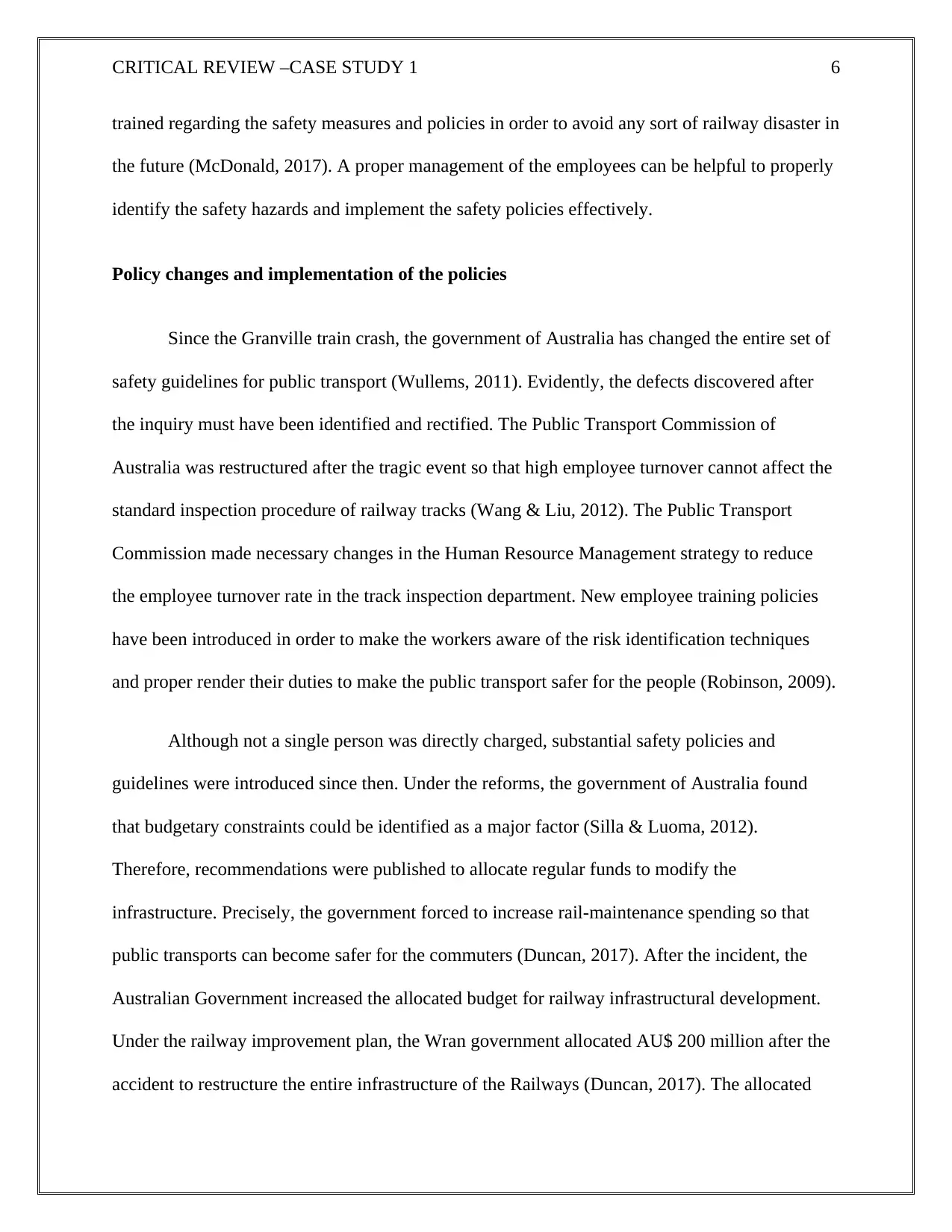
CRITICAL REVIEW –CASE STUDY 1 6
trained regarding the safety measures and policies in order to avoid any sort of railway disaster in
the future (McDonald, 2017). A proper management of the employees can be helpful to properly
identify the safety hazards and implement the safety policies effectively.
Policy changes and implementation of the policies
Since the Granville train crash, the government of Australia has changed the entire set of
safety guidelines for public transport (Wullems, 2011). Evidently, the defects discovered after
the inquiry must have been identified and rectified. The Public Transport Commission of
Australia was restructured after the tragic event so that high employee turnover cannot affect the
standard inspection procedure of railway tracks (Wang & Liu, 2012). The Public Transport
Commission made necessary changes in the Human Resource Management strategy to reduce
the employee turnover rate in the track inspection department. New employee training policies
have been introduced in order to make the workers aware of the risk identification techniques
and proper render their duties to make the public transport safer for the people (Robinson, 2009).
Although not a single person was directly charged, substantial safety policies and
guidelines were introduced since then. Under the reforms, the government of Australia found
that budgetary constraints could be identified as a major factor (Silla & Luoma, 2012).
Therefore, recommendations were published to allocate regular funds to modify the
infrastructure. Precisely, the government forced to increase rail-maintenance spending so that
public transports can become safer for the commuters (Duncan, 2017). After the incident, the
Australian Government increased the allocated budget for railway infrastructural development.
Under the railway improvement plan, the Wran government allocated AU$ 200 million after the
accident to restructure the entire infrastructure of the Railways (Duncan, 2017). The allocated
trained regarding the safety measures and policies in order to avoid any sort of railway disaster in
the future (McDonald, 2017). A proper management of the employees can be helpful to properly
identify the safety hazards and implement the safety policies effectively.
Policy changes and implementation of the policies
Since the Granville train crash, the government of Australia has changed the entire set of
safety guidelines for public transport (Wullems, 2011). Evidently, the defects discovered after
the inquiry must have been identified and rectified. The Public Transport Commission of
Australia was restructured after the tragic event so that high employee turnover cannot affect the
standard inspection procedure of railway tracks (Wang & Liu, 2012). The Public Transport
Commission made necessary changes in the Human Resource Management strategy to reduce
the employee turnover rate in the track inspection department. New employee training policies
have been introduced in order to make the workers aware of the risk identification techniques
and proper render their duties to make the public transport safer for the people (Robinson, 2009).
Although not a single person was directly charged, substantial safety policies and
guidelines were introduced since then. Under the reforms, the government of Australia found
that budgetary constraints could be identified as a major factor (Silla & Luoma, 2012).
Therefore, recommendations were published to allocate regular funds to modify the
infrastructure. Precisely, the government forced to increase rail-maintenance spending so that
public transports can become safer for the commuters (Duncan, 2017). After the incident, the
Australian Government increased the allocated budget for railway infrastructural development.
Under the railway improvement plan, the Wran government allocated AU$ 200 million after the
accident to restructure the entire infrastructure of the Railways (Duncan, 2017). The allocated
⊘ This is a preview!⊘
Do you want full access?
Subscribe today to unlock all pages.

Trusted by 1+ million students worldwide
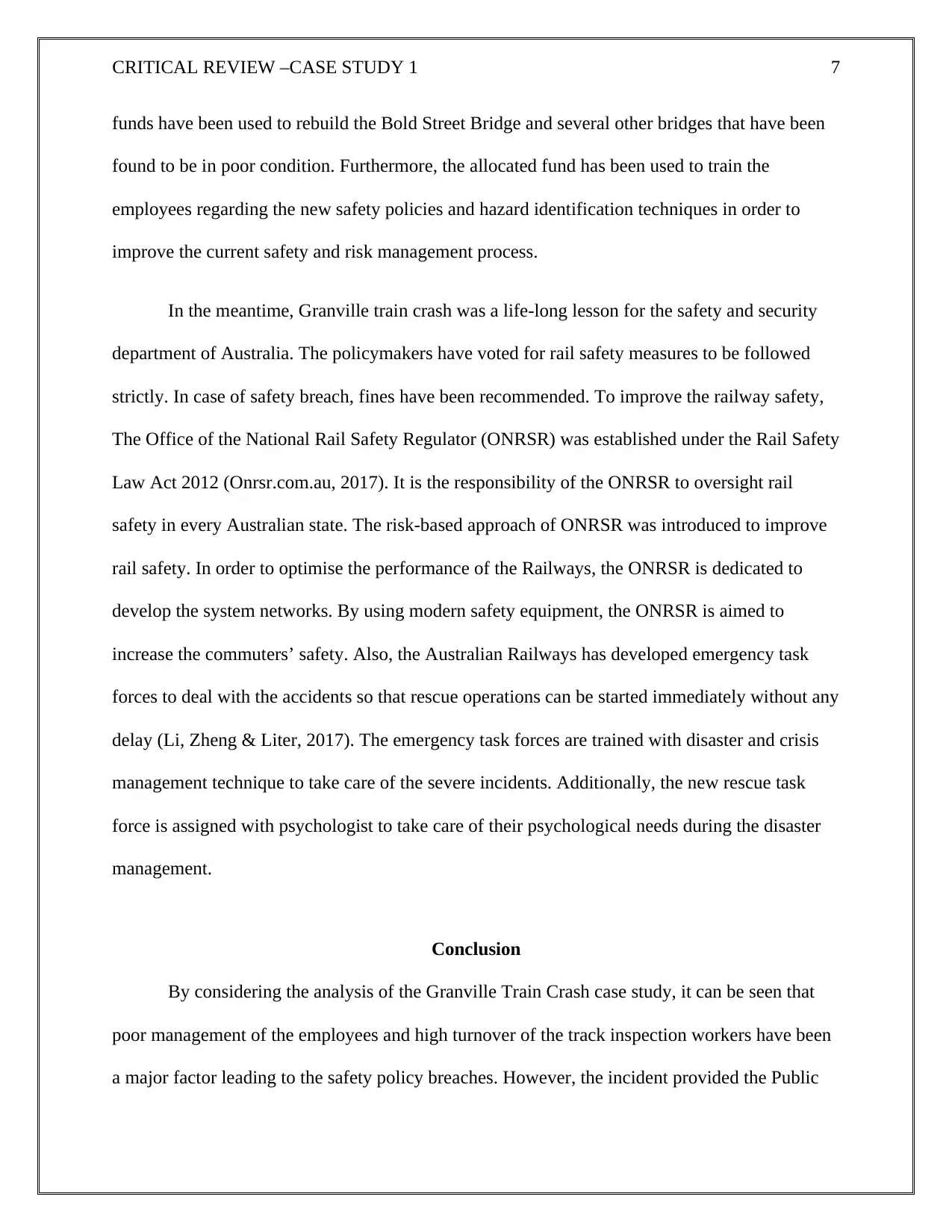
CRITICAL REVIEW –CASE STUDY 1 7
funds have been used to rebuild the Bold Street Bridge and several other bridges that have been
found to be in poor condition. Furthermore, the allocated fund has been used to train the
employees regarding the new safety policies and hazard identification techniques in order to
improve the current safety and risk management process.
In the meantime, Granville train crash was a life-long lesson for the safety and security
department of Australia. The policymakers have voted for rail safety measures to be followed
strictly. In case of safety breach, fines have been recommended. To improve the railway safety,
The Office of the National Rail Safety Regulator (ONRSR) was established under the Rail Safety
Law Act 2012 (Onrsr.com.au, 2017). It is the responsibility of the ONRSR to oversight rail
safety in every Australian state. The risk-based approach of ONRSR was introduced to improve
rail safety. In order to optimise the performance of the Railways, the ONRSR is dedicated to
develop the system networks. By using modern safety equipment, the ONRSR is aimed to
increase the commuters’ safety. Also, the Australian Railways has developed emergency task
forces to deal with the accidents so that rescue operations can be started immediately without any
delay (Li, Zheng & Liter, 2017). The emergency task forces are trained with disaster and crisis
management technique to take care of the severe incidents. Additionally, the new rescue task
force is assigned with psychologist to take care of their psychological needs during the disaster
management.
Conclusion
By considering the analysis of the Granville Train Crash case study, it can be seen that
poor management of the employees and high turnover of the track inspection workers have been
a major factor leading to the safety policy breaches. However, the incident provided the Public
funds have been used to rebuild the Bold Street Bridge and several other bridges that have been
found to be in poor condition. Furthermore, the allocated fund has been used to train the
employees regarding the new safety policies and hazard identification techniques in order to
improve the current safety and risk management process.
In the meantime, Granville train crash was a life-long lesson for the safety and security
department of Australia. The policymakers have voted for rail safety measures to be followed
strictly. In case of safety breach, fines have been recommended. To improve the railway safety,
The Office of the National Rail Safety Regulator (ONRSR) was established under the Rail Safety
Law Act 2012 (Onrsr.com.au, 2017). It is the responsibility of the ONRSR to oversight rail
safety in every Australian state. The risk-based approach of ONRSR was introduced to improve
rail safety. In order to optimise the performance of the Railways, the ONRSR is dedicated to
develop the system networks. By using modern safety equipment, the ONRSR is aimed to
increase the commuters’ safety. Also, the Australian Railways has developed emergency task
forces to deal with the accidents so that rescue operations can be started immediately without any
delay (Li, Zheng & Liter, 2017). The emergency task forces are trained with disaster and crisis
management technique to take care of the severe incidents. Additionally, the new rescue task
force is assigned with psychologist to take care of their psychological needs during the disaster
management.
Conclusion
By considering the analysis of the Granville Train Crash case study, it can be seen that
poor management of the employees and high turnover of the track inspection workers have been
a major factor leading to the safety policy breaches. However, the incident provided the Public
Paraphrase This Document
Need a fresh take? Get an instant paraphrase of this document with our AI Paraphraser

CRITICAL REVIEW –CASE STUDY 1 8
Transport Commission and the Australian Government with different lessons that have been
considered in order to introduce policy changes in the safety and risk management of public
transport. Furthermore, necessary policy reforms have been introduced by the Government to
effectively identify the hazards and implement, ensure and monitor the safety management
policies for healthy and safe journey of the people through Australian Railway Transportation
System.
Transport Commission and the Australian Government with different lessons that have been
considered in order to introduce policy changes in the safety and risk management of public
transport. Furthermore, necessary policy reforms have been introduced by the Government to
effectively identify the hazards and implement, ensure and monitor the safety management
policies for healthy and safe journey of the people through Australian Railway Transportation
System.
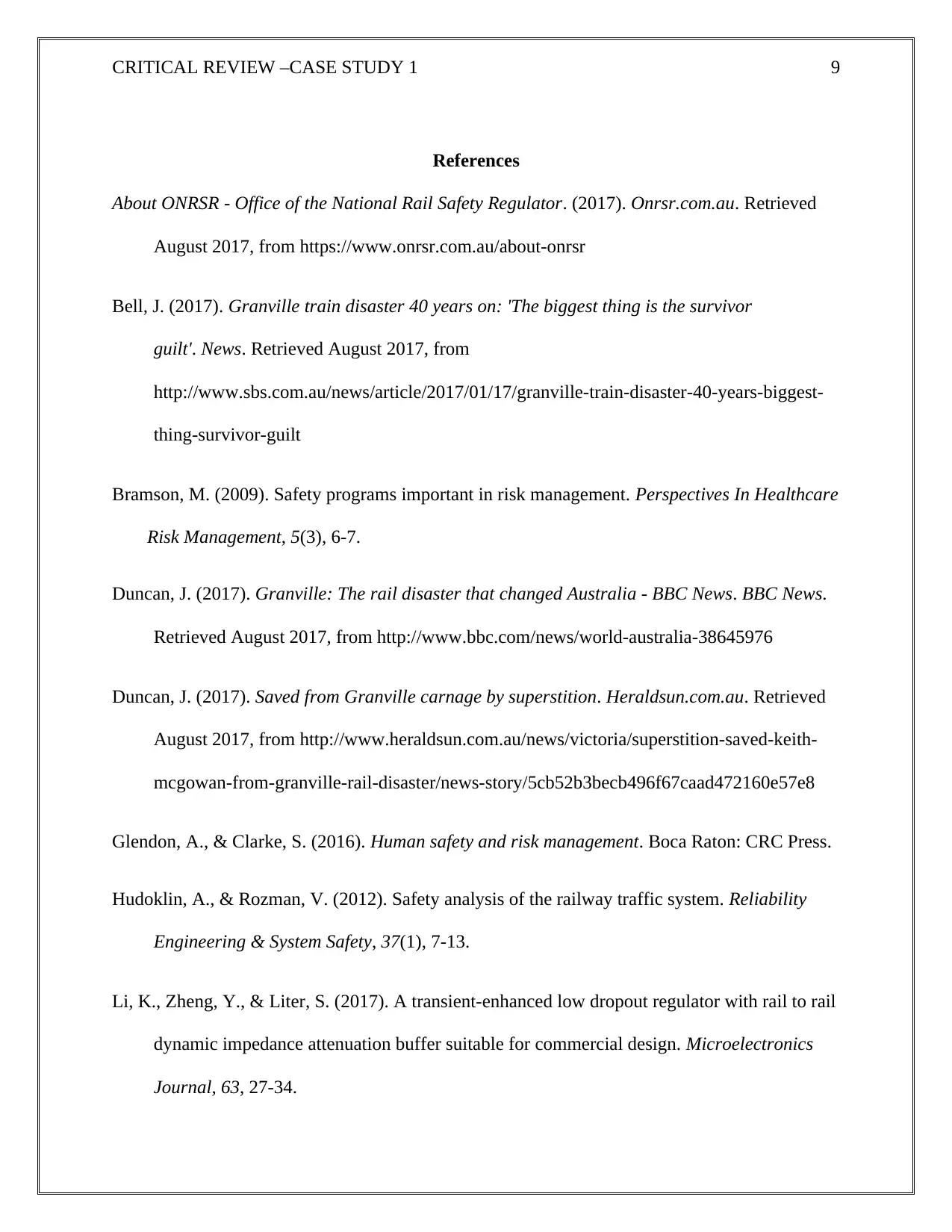
CRITICAL REVIEW –CASE STUDY 1 9
References
About ONRSR - Office of the National Rail Safety Regulator. (2017). Onrsr.com.au. Retrieved
August 2017, from https://www.onrsr.com.au/about-onrsr
Bell, J. (2017). Granville train disaster 40 years on: 'The biggest thing is the survivor
guilt'. News. Retrieved August 2017, from
http://www.sbs.com.au/news/article/2017/01/17/granville-train-disaster-40-years-biggest-
thing-survivor-guilt
Bramson, M. (2009). Safety programs important in risk management. Perspectives In Healthcare
Risk Management, 5(3), 6-7.
Duncan, J. (2017). Granville: The rail disaster that changed Australia - BBC News. BBC News.
Retrieved August 2017, from http://www.bbc.com/news/world-australia-38645976
Duncan, J. (2017). Saved from Granville carnage by superstition. Heraldsun.com.au. Retrieved
August 2017, from http://www.heraldsun.com.au/news/victoria/superstition-saved-keith-
mcgowan-from-granville-rail-disaster/news-story/5cb52b3becb496f67caad472160e57e8
Glendon, A., & Clarke, S. (2016). Human safety and risk management. Boca Raton: CRC Press.
Hudoklin, A., & Rozman, V. (2012). Safety analysis of the railway traffic system. Reliability
Engineering & System Safety, 37(1), 7-13.
Li, K., Zheng, Y., & Liter, S. (2017). A transient-enhanced low dropout regulator with rail to rail
dynamic impedance attenuation buffer suitable for commercial design. Microelectronics
Journal, 63, 27-34.
References
About ONRSR - Office of the National Rail Safety Regulator. (2017). Onrsr.com.au. Retrieved
August 2017, from https://www.onrsr.com.au/about-onrsr
Bell, J. (2017). Granville train disaster 40 years on: 'The biggest thing is the survivor
guilt'. News. Retrieved August 2017, from
http://www.sbs.com.au/news/article/2017/01/17/granville-train-disaster-40-years-biggest-
thing-survivor-guilt
Bramson, M. (2009). Safety programs important in risk management. Perspectives In Healthcare
Risk Management, 5(3), 6-7.
Duncan, J. (2017). Granville: The rail disaster that changed Australia - BBC News. BBC News.
Retrieved August 2017, from http://www.bbc.com/news/world-australia-38645976
Duncan, J. (2017). Saved from Granville carnage by superstition. Heraldsun.com.au. Retrieved
August 2017, from http://www.heraldsun.com.au/news/victoria/superstition-saved-keith-
mcgowan-from-granville-rail-disaster/news-story/5cb52b3becb496f67caad472160e57e8
Glendon, A., & Clarke, S. (2016). Human safety and risk management. Boca Raton: CRC Press.
Hudoklin, A., & Rozman, V. (2012). Safety analysis of the railway traffic system. Reliability
Engineering & System Safety, 37(1), 7-13.
Li, K., Zheng, Y., & Liter, S. (2017). A transient-enhanced low dropout regulator with rail to rail
dynamic impedance attenuation buffer suitable for commercial design. Microelectronics
Journal, 63, 27-34.
⊘ This is a preview!⊘
Do you want full access?
Subscribe today to unlock all pages.

Trusted by 1+ million students worldwide
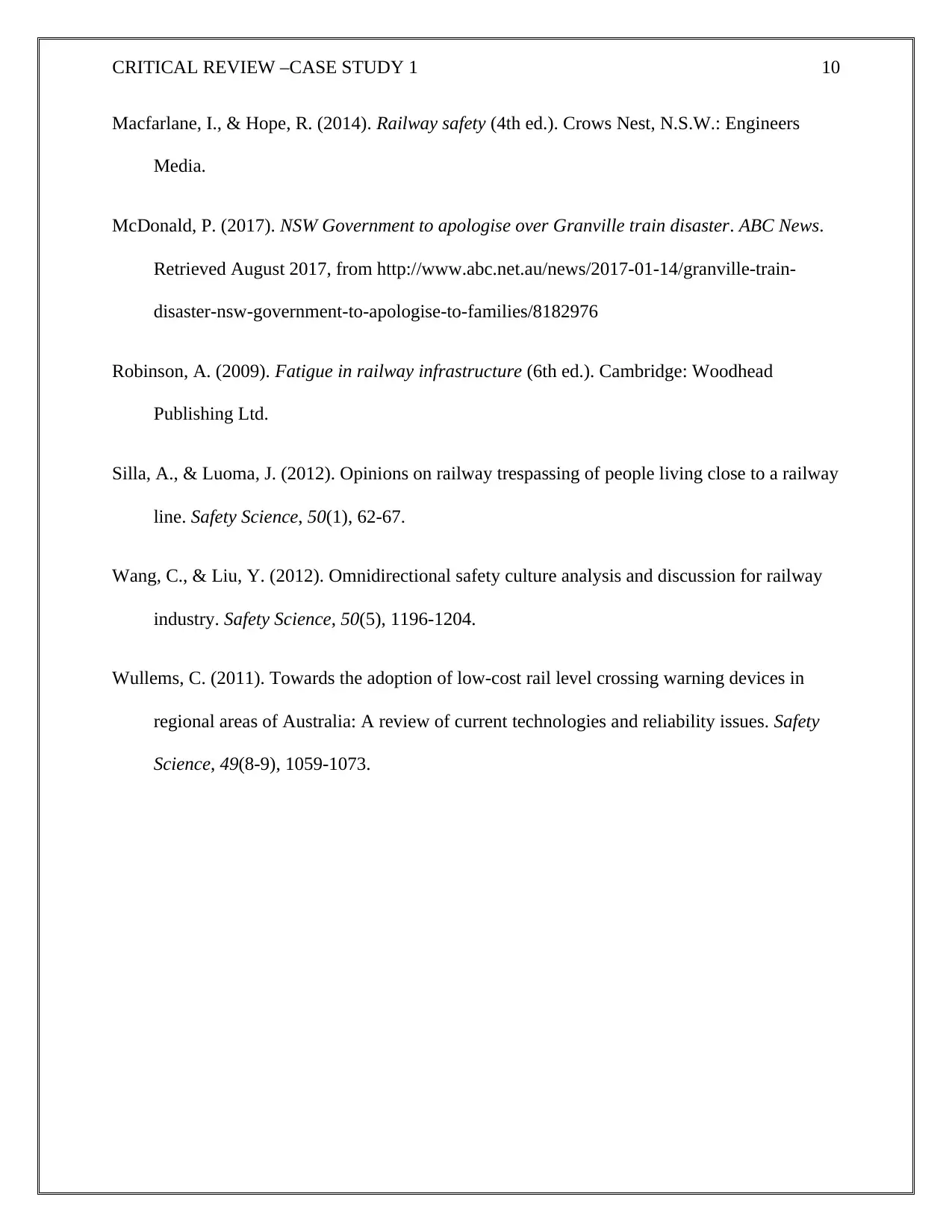
CRITICAL REVIEW –CASE STUDY 1 10
Macfarlane, I., & Hope, R. (2014). Railway safety (4th ed.). Crows Nest, N.S.W.: Engineers
Media.
McDonald, P. (2017). NSW Government to apologise over Granville train disaster. ABC News.
Retrieved August 2017, from http://www.abc.net.au/news/2017-01-14/granville-train-
disaster-nsw-government-to-apologise-to-families/8182976
Robinson, A. (2009). Fatigue in railway infrastructure (6th ed.). Cambridge: Woodhead
Publishing Ltd.
Silla, A., & Luoma, J. (2012). Opinions on railway trespassing of people living close to a railway
line. Safety Science, 50(1), 62-67.
Wang, C., & Liu, Y. (2012). Omnidirectional safety culture analysis and discussion for railway
industry. Safety Science, 50(5), 1196-1204.
Wullems, C. (2011). Towards the adoption of low-cost rail level crossing warning devices in
regional areas of Australia: A review of current technologies and reliability issues. Safety
Science, 49(8-9), 1059-1073.
Macfarlane, I., & Hope, R. (2014). Railway safety (4th ed.). Crows Nest, N.S.W.: Engineers
Media.
McDonald, P. (2017). NSW Government to apologise over Granville train disaster. ABC News.
Retrieved August 2017, from http://www.abc.net.au/news/2017-01-14/granville-train-
disaster-nsw-government-to-apologise-to-families/8182976
Robinson, A. (2009). Fatigue in railway infrastructure (6th ed.). Cambridge: Woodhead
Publishing Ltd.
Silla, A., & Luoma, J. (2012). Opinions on railway trespassing of people living close to a railway
line. Safety Science, 50(1), 62-67.
Wang, C., & Liu, Y. (2012). Omnidirectional safety culture analysis and discussion for railway
industry. Safety Science, 50(5), 1196-1204.
Wullems, C. (2011). Towards the adoption of low-cost rail level crossing warning devices in
regional areas of Australia: A review of current technologies and reliability issues. Safety
Science, 49(8-9), 1059-1073.
1 out of 10
Related Documents
Your All-in-One AI-Powered Toolkit for Academic Success.
+13062052269
info@desklib.com
Available 24*7 on WhatsApp / Email
![[object Object]](/_next/static/media/star-bottom.7253800d.svg)
Unlock your academic potential
Copyright © 2020–2025 A2Z Services. All Rights Reserved. Developed and managed by ZUCOL.





